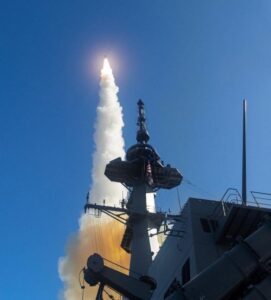The Missile Defense Agency (MDA) is seeking market research in preparation of a 10-year upgrade to the Standard Missile-3 (SM-3) family of missiles, according to a request for information (RFI) published April 13.
The market research aims to “determine interest and capability for sources to fulfill the requirements of the Standard Missile-3 (SM-3) Program,” the RFI said.

Specifically, this will cover the development, advanced development systems engineering support, integration, analysis, configuration and data management, information security, quality assurance and testing of upgrades required for the SM-3 Block IB and SM-3 Block IIA All-Up Rounds (AUR).
“This market research is being used to determine the capability of industry. Respondent current capabilities will be assessed in terms of demonstrated record of successful implementation and support of SM-3 acquisition efforts or missile-related development efforts of similar size, scope, and technical complexity,” the document reads.
MDA will then use the industry responses to develop acquisition strategy alternatives that aim to increase competition in the SM-3 future development space.
The RFI says the agency expects the contracting effort to start in fiscal year 2024 with a period of performance lasting up to 10 years, depending on the final approved contract strategy.
According to the RFI, it specifically seeks to help MDA make informed acquisition decisions based on several factors.
These include the ability to assess industry and marketplace capacity and capability to deliver SM-3 capabilities and requirements; gain industry recommendations on acquisition strategies and approaches; identify and assess any potential major acquisition risks; identify and mitigate potential competition barriers; industry data and information needed to support the proposal preparations; outline program cost drivers, potential cost impacts and risks; and find areas that could be set aside for small business.
The notice underscored as an RFI MDA is seeking market research for information planning purposes and this is not a Request for Proposals or a commitment for one.
The notice said current capabilities of respondents will be assessed in terms of a demonstrated record of successfully implementing and supporting SM-3 acquisition efforts “or missile-related development efforts of similar size, scope, and technical complexity.”

The notice specified several scope requirements and considerations that respondents should note experience on including SM-3 data management; systems engineering and integration of SM-3 Block IB and SM-3 Block IIA enhancements; development/enhancement of SM-3 Block IB and SM-3 Block IIA missile hardware and software for new capabilities to enhance missiles and address obsolescence and technology insertion in the current architecture; and development and qualification of new SM-3 Block IB Throttleable Divert Attitude Control System (TDACS) propellant to support service life extension of in-service SM-3 Block IB AURs.
Responses are due by April 27.
Raytheon Technologies [RTX] has been the prime contractor and producer of the SM-3 missiles. The Block IIA variant came from a co-development agreement between the U.S. and Japan.